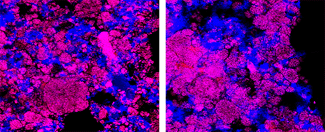Increasing the performance of wastewater treatment plants

Wastewater treatment plants are currently one of the most important systems at hand to minimise the dumping of pollutants into the environment. One of the processes, which are used in these facilities, is what is known as EBPR (Enhanced Biological Phosphorus Removal), although, on occasions, difficulties may arise which hinder the performance of pollutant elimination. Researchers at the Department of Chemical Engineering have studied this problem in depth, providing new knowledge about the EBPR process.
European regulation 271/91/CEE has meant that most of the Wastewater Treatment Plants (WWTP) in Europe have had to adapt to more restrictive conditions on the discharge of water, mainly with reference to the concentration of nitrogen and phosphorous in effluent. In the elimination of phosphorous from wastewater, the biological process known as EBPR (Enhanced Biological Phosphorus Removal) is widely accepted as an economic and sustainable process, although it is more complex than the biological elimination of organic material or nitrogen.
The implementation of EBPR in an WWTP consists of setting up anaerobic zones (without oxygen) and aerobic zones (with oxygen) in various reactors within the WWTP, in order to foster the growth of microorganisms known as PAO (Polyphosphate Accumulating Organisms). In anaerobic conditions PAO are able to store organic material in the form of reserve polymers (polyhydroxyalkanoates, PHA). In order to do so they require energy, which they obtain mainly by means of the hydrolysis of intracellular polyphosphate, which leads to a release of phosphate into the environment. In a later aerobic stage the PAO use the stored PHA to grow and capture phosphate from the environment in order to replenish their reserves of intracellular polyphosphate. This capture is greater than the release in the anaerobic stage so that we get a net reduction of phosphate in the environment with respect to the initial concentration in the wastewater.
The EBPR process may present operating problems that affect the elimination performance. For example, excessive aeration in an WWTP may deteriorate its efficiency. This may occur in periods of abundant rain, leading to an increased hydraulic load on the treatment plant, which also may lead to an increase in the amount of dissolved oxygen in the WWTP stage designed to be anaerobic. What has not been explained is why this loss of activity is produced.
The work undertaken by our research group has shown that the PAO micro organisms, in aerobic conditions, use the same metabolic processes as in anaerobic conditions, that is they accumulate organic material and release phosphate into the environment and later are able to accumulate this phosphate when the organic material dissolved in the environment has run out. The work carried out has shown that this aerobic phosphate elimination may be maintained under various operating conditions, but is lost if the strict aerobic conditions are met for more than 4 days.
The loss of PAO activity does not imply an elimination of this type of microorganism from the system, but that the PAO stop using these processes because they have more efficient metabolic processes available under the new conditions. These new findings about the EBPR process are important when attempting to detect problematical situations in WWTP and allow us to propose new control strategies to prevent the failure of biological phosphate elimination, given that recovery time is often long and complicated.

Photographs obtained with a confocal laser microscope and FISH identification techniques. PAO detection (in pink) and other bacteria (in blue). On the left the initial population in the reactor, on the right after eleven days’ aerobic operation. We can see the changes in performance are the consequence of a metabolic adaptation to the new situation rather than a change in population.
References
Article: "Net P-removal deterioration in enriched PAO sludge subjected to permanent
aerobic conditions". M. Pijuan, A. Guisasola, J.A. Baeza, J. Carrera, C.Casas, J. Lafuente, J. Biotechnol, 123(1): 117-126 (2006).


